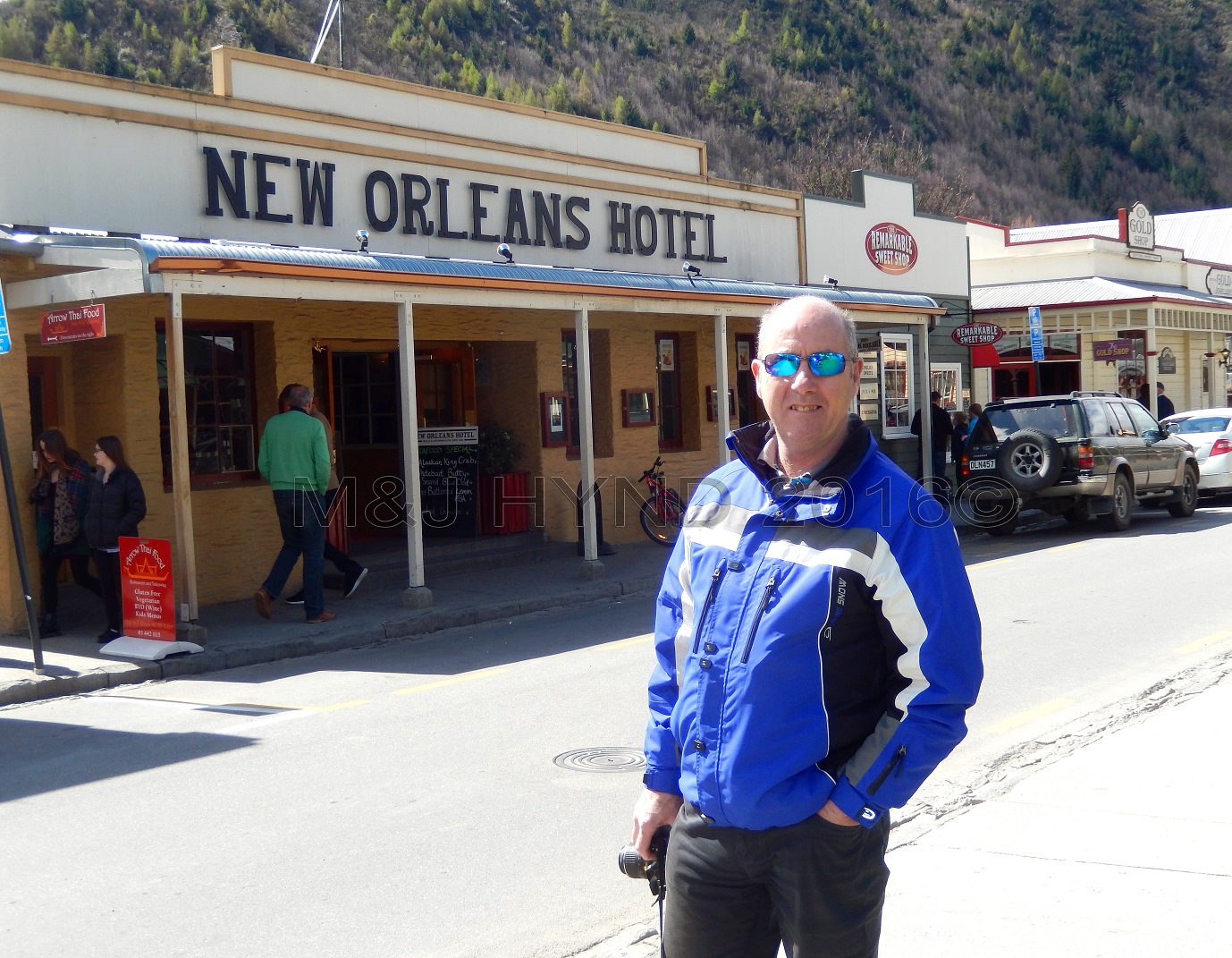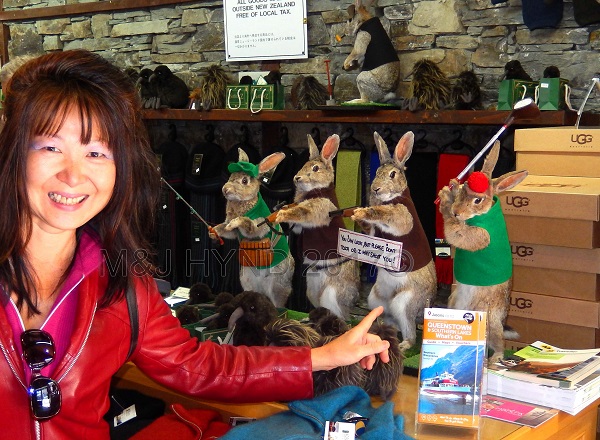Central Otago: Arrowtown, Cardrona, Wooing Tree Winery
We were in Queenstown for a few days, so hired a rental car to see the out of town sights. Morning collection, where should we go? There were lots of routes into the hinterland in the surrounding areas, too many to choose from methinks. Some we had done a few with friends, others we would have to leave for next time. Arrowtown and Cardrona beckoned. Perhaps we should also do some wine tasting enroute. It was a push for time to do it all, but we're going to try.
This had a spark of deja-vu about it: distant memories brought back in a heartbeat, of a rush tour of the South Island at the end of my university days... basing ourselves in Queenstown on the Frankton Arm lake-front. First up was Arrowtown, a historic gold mining town 20 minutes drive east, under the shadow of Coronet Peak (also the name of the largest skifield in the area).
Arrowtown is still a lovely place, very quaint, full of olde-worlde styled shoppes, cafes and restaurants. I remember loads of knitwear establishments. They may still be the ones I had a look at aeons ago, or these were new businesses. All the same, it had the same nostalgic feeling.
We wandered up and down its main street. Stopping to take photos of things that you don't often see: an assayers company office. Price of gold; economic developments of the gold rush that wrought a profound change on the Otago, one can only imagine. Reminder of the old Western movies, a one horse town... with saloon-type doors swinging. Perhaps it was just like that in the gold-rush period it had as its legacy.
The Arrowtown Chinese Settlement was a historic village located on the outskirts of town setup by the Chinese population in the 1860's Otago gold rush. The settlement is sometimes referred to as a village and has been restored and is now a common tourist attraction. It is close to Arrowtown on the banks of Arrow River. During the height of the gold rush the population of Arrowtown rose to over 7,000 and became the centre of a larger municipality, which covered many new settlements. Now, sadly only ghost towns.
Cardrona was next on the list. I'd only known it as a very difficult to get to ski-field, as it is situated in the steep narrow Cardrona Valley, and the location of one of New Zealand's most notoriously demanding roads, the Crown Range route. Caravans and large vehicles were banned from the road for years, and it was only fully sealed in 2001. The road up on the Queenstown side of the range is very steep, and is regularly closed to vehicles without chains during winter because of black ice.
Cresting the top, the valley tracks 40km northeast towards Wanaka. About 14km down the road the distinctive gold rush vintage Cardrona Hotel is one of the few remaining buildings from that era, and it sits on the opposite side of the river where the original Cardrona township used to exist It is in a ruggedly scenic setting, complete with a 1930s era car parked out front and the backdrop of awesome mountains and endless blue skies.
Stepping into the Hotel for lunch, it was a step back in time to another era; dark heavy timber, a solid stone fireplace, smaller windows and a massive bar. Despite the sharp clear sunlight outside there was a definite chill in the air off the mountains, and we entered inside to a welcoming log fire burning merrily in the centre of the dining room, with large leather couches by the fireplace gently toasting the customers.
We ordered something hot. When it arrived, the piping hot dish reminded me of gulaschsuppe (goulash soup), the signature dish of the Austrian Alps we enjoyed when skiing in Austria before my stroke. The lunch was always gulaschsuppe – satisfying, good sized chunks of beef and garlic-infused, thick gravy with potato plus red peppers, bacon, onions, and garlic, all made fragrant with paprika. A hearty, satisfying meal. Murray had the same as well as some croquettes. Other diners were tucking into a variety of food on offer, it was pleasantly warm and cosy.
I didn't want to move; so lost in the recesses of the leather armchair after the meal. Eventually I roused myself, and thought about... hmmm, dessert? Perhaps, we (!) could squeeze-in a slice of that lovely caramel slice just waiting to be eaten, winking at me, from its perch on the laden dessert counter. Done deal – plus coffee. Excellent. After that, we wandered out the back where the Cardrona Hotel had guest accommodation. Very nice indeed.
The Cardrona Hotel is one of New Zealand’s oldest and most iconic hotels. The breathtaking scenery, a relaxed and charming atmosphere and superb high country hospitality, the Cardrona Hotel is the ideal venue for events, from 50th birthdays, product launches, corporate functions, anniversaries, engagement, hen parties, weddings, offering a rustic ambience and historic charm.. Canapes and cocktails, in a cosy restaurant and serving top quality wines from some of the region's best wineries. Then the accommodation just next door? - very handy!
The temperature had dropped more than significantly when we came out of hotel, as snow flurries spun in the air in front of our noses and it was getting heavier... winter hasn’t quite gone yet. Thought: the caramel slice was well-timed. I took a few photos of the surrounds and quickly got into the warmth of the car.
We made a quick visit to Felton Road Wines. It is a restful, peaceful area, fields planted with grapevines though too early for ripening yet, they were just sticks in the ground. From the first vintage in 1997, Felton Road has acquired a formidable worldwide reputation. Plump richness, intense, fruit driven, expressive - pinot noir; zesty, aromatic, floral, fruity and more, are the notes of whites.
Winery lees, mixture of sediments left over from winemaking, some of it goes into composting. The rest is distilled into “Fine”, which is brandy distilled from wine lees; after aging in French oak, it is ready to bottle. More age will only make it more sophisticated.
Ah, the penny drops. So now it becomes slightly clearer, to understand when we visited the official growing area of the Pedro Ximenes grape variety in Jerez de la Frontera, some time ago in Spain. The searing Andalucian sun concentrates the sweetness of this particular type of grape to produce a thick, dark almost black liquid with a strong taste of raisins and molasses. It is fortified and aged in solera; and used to produce an intensely sweet and dark dessert sherry.
It is a silky, sultry, drop; unctuous on the tongue, absolutely. We have tasted this elixir, and described it as “heavenly liquid raisins” to friends.
Jerez de la Frontera is the sherry, or fortified wine, capital of Spain. Jerez, as it is colloquially known, is north of Cadiz and in the so-called sherry triangle, which consists of Jerez, El Puerto de Santa María, and Sanlúcar de Barrameda.
Jerez is known as the city of flamenco, sherry, and its myriad of Moorish influences. We were specifically in Jerez to visit the Gonzales Byass bodega (winery). On our way to finding it, we actually took a wrong turn and through manic traffic, we passed the magnificent Catedral de San Salvador de Jerez de la Frontera with its gigantic doors. The wondrous things you see when you are not really looking for them (!?).
Gonzalez Byass is world reknowned for its high quality sherry, which has been produced in Jerez for over 175 years. It is best known for its award-winning, ultra-dry Fino, Tio Pepe; an aperitif, great for a chilling away on hot a summers' day. Near the other end of the spectrum is the ultra-suave, intensely sweet and almost black, Nectar sherry, which is great as a companion for sweet desserts.
The bodega tour was very informative and actually uncovered a novel myth. Rumour had it that there was no cats employed to rid the mice that ran through the bodega's hallowed halls. Instead, the mice were supplied with tiny step-ladders that allow them to get a tasty drink from a biggish glass of sherry and another for a nibble of cheese. The reasoning was that an already fed and drunk mouse didn't go looking for another drink, so wouldn't attempt to gnaw through the cask corks. A drunken mouse - myth or truth? Perhaps a very fast mouse like the cartoons of Speedy Gonzales, or Roadrunner (& Wile E. Coyote), and dressed up like the one in Tio Pepes signature colour and dress of Gonzalez Byass: red hat & bolero jacket, carrying a guitar; almost a national symbol? This I had to see... and, it's actually very true.
On the road again outside Queenstown … to Wooing Tree vineyard. And another tasting. I tried two rosé wines; refreshingly different. These rosé wines had attractive berry notes, fresh and vibrant . Decision-time yet again: which bottle/case should we buy...?
Wooing Tree Vineyard is such a different name, I had to get the origin of where the name came from. Wooing Tree is a local landmark and has long been a place for locals to woo their lovers. Apparently there are plenty of courtships still going on at the Wooing Tree. Proposing marriage and even getting married under the beautiful iconic tree, amidst the vines is a romantic thought.
Have your romantic wedding at Wooing Tree Vineyard amongst the vines? .. perhaps, in a retro, classic, vintage wedding-car - the church and reception on time in high style and comfort.
There was even a ball gown at the winery, all made from wine-bottle wrappers – expertly done, it actually looked quite expensive although maybe a little scratchy to wear. Very eye-catching indeed. Wooing Tree had a terrific lunch menu as well, so eating here is on the agenda if we venture south again.

















